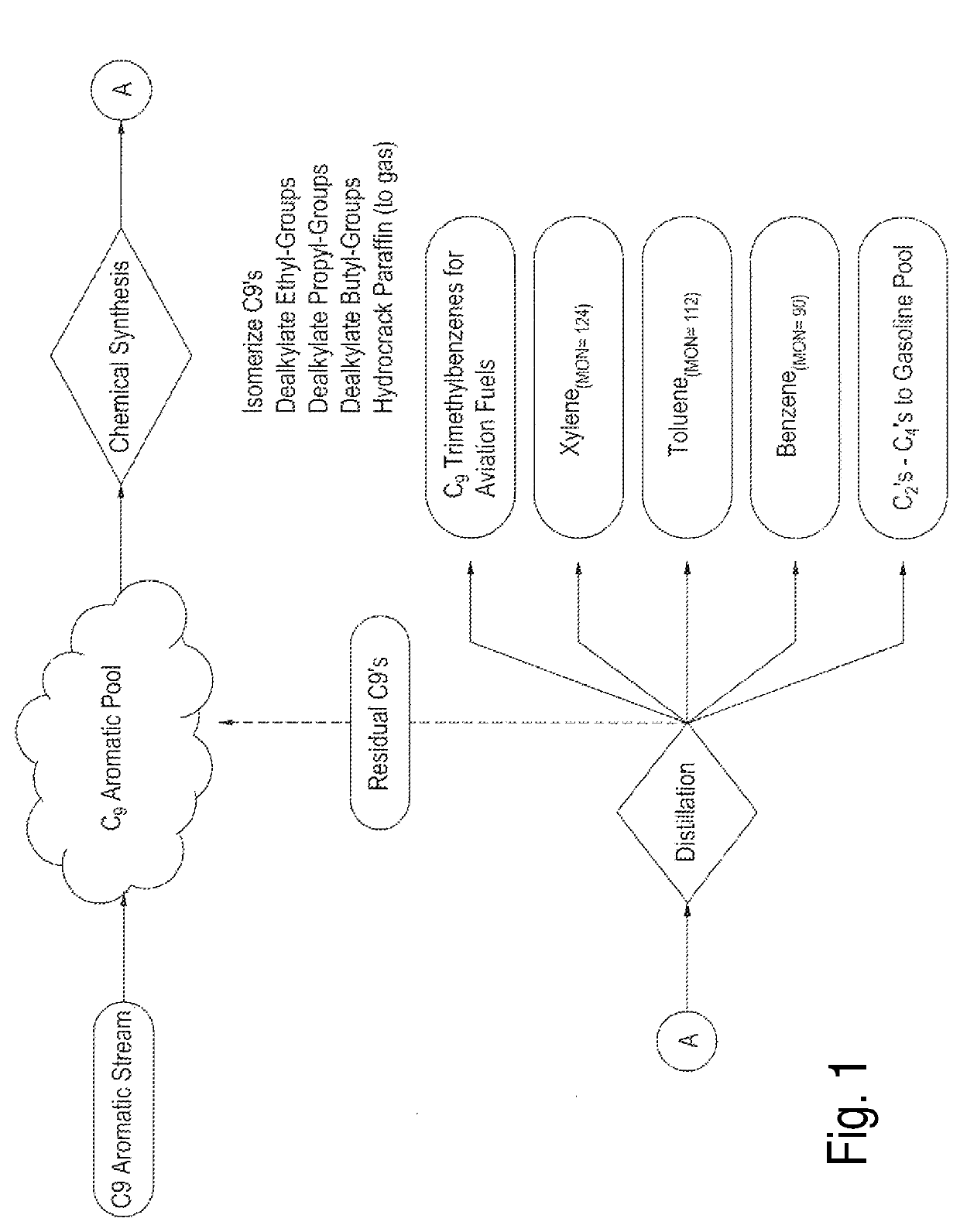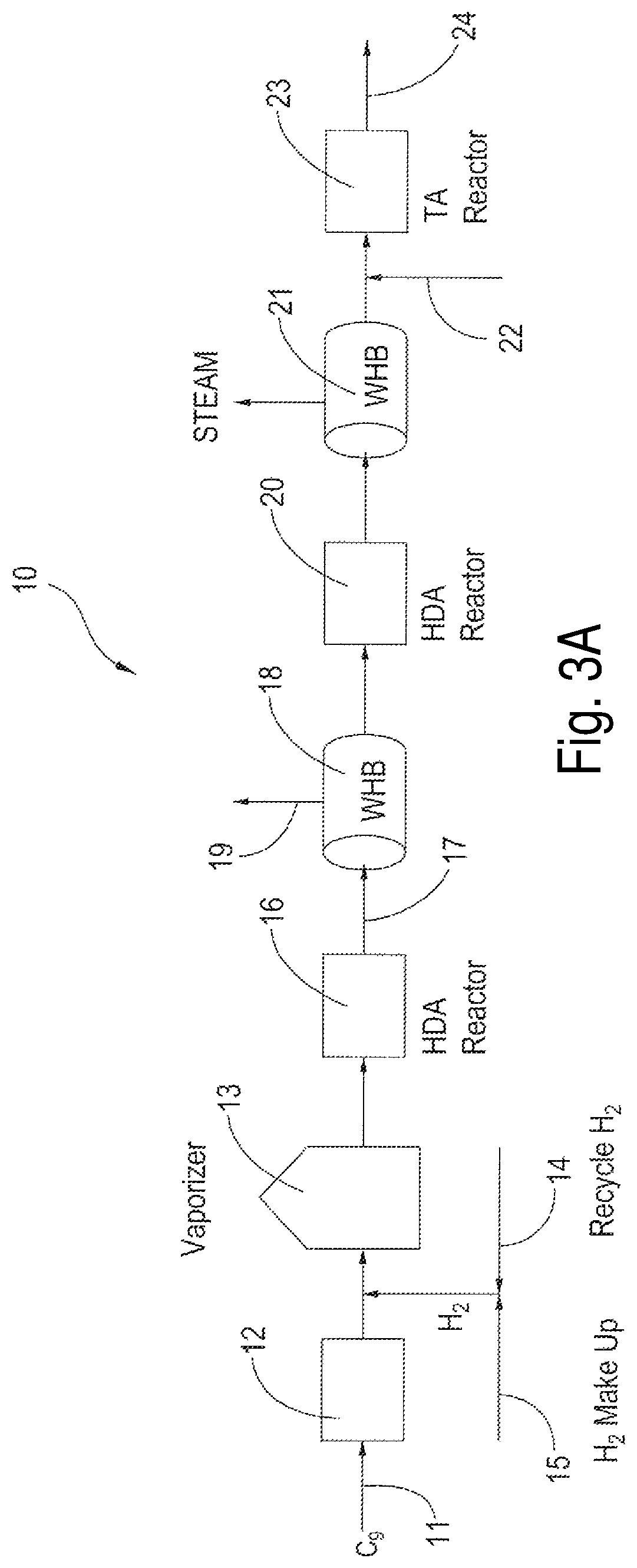Treating C8-C10 aromatic feed streams to prepare and recover trimethylated benzenes
a technology of aromatic feed streams and trimethyl benzenes, which is applied in the field of preparation of trimethyl benzenes, can solve the problems that the technology does not meet the need for high octane fuels, and achieve the effects of maximizing the yield of high-octane fuels, reducing volume loss, and increasing the octane number of refinery streams
- Summary
- Abstract
- Description
- Claims
- Application Information
AI Technical Summary
Benefits of technology
Problems solved by technology
Method used
Image
Examples
example 1
C9 Aromatic Stream
[0080]A C9 aromatic stream from a naphtha reformer and related process units contains a mixture of aromatic isomers some of which have much higher octane ratings than other isomers in that stream. A typical C9 stream also includes other components, as shown for example in FIG. 19. The C9 stream from the naphtha reformer, or other source, may also comprise significant amounts of C8 and C10 aromatics.
example 2
MON Improvement
[0081]By way of example, a C9 aromatic stream was determined to have the chemical composition shown in FIG. 20. After the hydrodealkylation, transalkylation and isomerization, and cracking of paraffins, the resulting mixture of tri-methyl C9-aromatics showed a ratio as described in FIG. 21. The resulting comparison of motor octane numbers (ASTM D2700) reveals that the original octane number of the combined C9 stream was 100.7 MON, which was increased to 111 as a result of the invention. The high-value aromatic components once distilled can be blended, whereby the trimethylbenzene can be utilized directly as a high-octane aviation fuel or as a fuel component. The C8 xylenes byproducts can either be processed into a BTX unit, used in high-octane gasoline blendstocks, distilled for commercial use, or they may be processed along with C10's via the trans-alkylation technique to make additional C9 aromatics, subject to the economic tradeoffs of the process.
example 3
Breakdown of Ethyl and Propyl Compounds
[0082]An aromatic stream comprising C8 and C9 aromatics was analyzed for chemical composition following hydrodealkylation. It was confirmed that the ethyl compounds converted to toluene and ethane, and the propyl compounds to benzene and propane, as shown in FIG. 22.
[0083]After the isomerization, dealkylation, and cracking of paraffins, the resulting components of the tri-methyl C9 aromatics are more easily distilled in the absence of ethyl, propyl and butyl groups. The initial ratios are further enhanced by C9's produced during the transalkylation process as shown in FIG. 23.
[0084]The resulting comparison of motor octane numbers (ASTM D2700) showed that the original octane number of the combined C8 and C9 stream was 102.1 MON, which increased to 111 as a result of the invention.
PUM
| Property | Measurement | Unit |
|---|---|---|
| vol % | aaaaa | aaaaa |
| vol % | aaaaa | aaaaa |
| MON | aaaaa | aaaaa |
Abstract
Description
Claims
Application Information
 Login to View More
Login to View More - R&D
- Intellectual Property
- Life Sciences
- Materials
- Tech Scout
- Unparalleled Data Quality
- Higher Quality Content
- 60% Fewer Hallucinations
Browse by: Latest US Patents, China's latest patents, Technical Efficacy Thesaurus, Application Domain, Technology Topic, Popular Technical Reports.
© 2025 PatSnap. All rights reserved.Legal|Privacy policy|Modern Slavery Act Transparency Statement|Sitemap|About US| Contact US: help@patsnap.com



